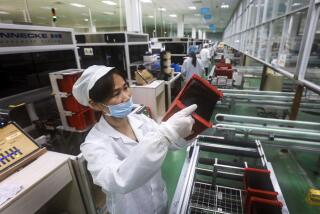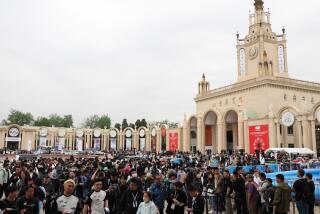U.S. and China agree to partial trade deal, but few details are released
WASHINGTON — The United States and China reached a preliminary trade agreement that includes the rollback of some tariffs on Chinese imports and a commitment by Beijing to make a substantial increase in purchases of American farm goods and other products and services.
A final settlement on the so-called Phase 1 deal could help defuse tensions after a long-festering trade war that has convulsed financial markets, hampered the global economy and added to deepening strains between the two superpowers.
Trump hailed the agreement Friday as a “phenomenal deal.” Minutes earlier, at a late-night news conference in Beijing, Chinese officials confirmed there was an agreement.
But few details were released, and where there were specifics — notably from the U.S. side — they were stated in a vague and in some cases confusing manner.
Over the last two years of a tit-for-tat trade war, previous tentative deals to resolve the standoff have fallen apart before completion, sending both sides back to the negotiating table. And even if the latest agreement is finalized, it is a far cry from the comprehensive deal Trump once promised to force China to dramatically reshape its practices.
The U.S. Trade Representative, in a fact sheet released Friday evening, said China had committed “to import various U.S. goods and services over the next two years in a total amount that exceeds China’s annual level of imports for those goods and services in 2017 by no less than $200 billion.” That apparently means China would boost U.S. imports by at least $100 billion, on average, in 2020 and 2021.
According to U.S. data, American exports of goods and services to China were about $190 billion in 2017. Chinese exports to the U.S. totaled about $525 billion.
China “is expected to continue on this same trajectory for several years after 2021 and should contribute significantly to the rebalancing of the U.S.-China trade relationship,” the USTR said.
Chinese officials, however, gave no details of purchases or the tariff relief. They said the agreement still has to go through “legal review, translation and proofreading.”
“There is no doubt that China will increase purchases of high-quality agricultural products from the U.S.,” said Ning Jizhe, vice chairman of the National Development and Reform Commission, a key economic planning agency. “As for the specific details and statistics of the agreement, they will be released later.”
Trump, in a tweet Friday, confirmed he was withdrawing his threat to slap 15% tariffs on about $160 billion of Chinese imports on Sunday. The president was widely expected to pull back on those tariffs, which would have hit consumers with higher costs for phones, laptops and toys.
In addition, Trump said he was halving similar taxes on about $120 billion of goods from China, but would keep in place 25% tariffs on another $250 billion of imports, as a bargaining chip for further talks. He said negotiations on a Phase 2 deal would begin right away instead of after the 2020 U.S. election, as he had previously indicated.
When Trump first announced the Phase 1 deal in early October, he said the Chinese had agreed to buy $40 billion to $50 billion of U.S. farm goods — about double the average annual amount in recent years prior to the trade war.
The president has been keen to shore up support from farmers, an important political constituency who have been crushed by China’s retaliatory tariffs on U.S. soybeans and other farm goods. Trump already has provided about $20 billion in cash aid to farmers through an obscure federal commodities development program.
“And I say, affectionately, the farmers are going to have to go out and buy much larger tractors, because it means a lot of business, a tremendous amount of business,” Trump said Friday from the Oval Office.
Chinese officials, however, were more circumspect. Pressed at the news conference in Beijing, they declined to provide specifics on the amount, type or timing of purchases of U.S. agricultural products by China, saying only that the increase would be by a “notable margin.”
Analysts say China would be hard pressed to make a commitment as large as the U.S. was suggesting, considering its trading relations with other countries and the potential for changing consumer needs and preferences from Chinese buyers.
Nor did the Chinese provide details on the amount of tariff reductions by both sides.
Wang Shouwen, vice minister of commerce and deputy international trade representative, reading from a script announcing the agreement, said the U.S. would fulfill its commitments to remove tariffs on Chinese products “phase by phase.”
Chinese officials said the Phase 1 deal contained nine chapters, including intellectual property rights, technology transfer, food and agriculture, financial services and exchange rates and transparency.
It was unclear, however, to what extent the agreement dealt with central concerns the U.S. has raised in the past, such as Chinese policies that pressure foreign firms to hand over technology and trade secrets in order to have access to China’s markets. The trade representative’s office said there were “binding and enforceable obligations to address several” of these practices.
There was no mention of China’s heavy subsidization of state-owned enterprises, another long-standing complaint on the part of the U.S. that is at the heart of Beijing’s industrial policies.
Short as it was on details, news of the deal was still welcomed by U.S. business groups. Myron Brilliant, the U.S. Chamber of Commerce’s head of international affairs, said the agreement would create greater certainty for businesses.
Brian Kuehl, a farmer in Wyoming and co-executive director of the group Farmers for Free Trade, said: “Our hope is that this is not another empty political promise to farmers.”
But on both sides of the Pacific, the deal was met with considerable skepticism and doubts that it would lead to a comprehensive agreement or a significant improvement in U.S.-China relations.
“The Phase 1 deal is temporary reconciliation, not complete cease-fire, between China and the U.S.,” said Wang Jun, deputy director of the department of information at the China Center for International Economic Exchanges, in the Communist Party-owned outlet Global Times. “It’s difficult for the two countries’ relations to return to where they were before the trade war broke.”
David Loevinger, a former senior Treasury official on China affairs, said after watching the Chinese news conference late Friday that the announcement was “pretty much in line with prior expectations for a mini-skinny deal.”
He noted there was no “heavy policy lifting” from either side: no firm commitment from the Chinese on farm purchases; nothing on easing of U.S. restrictions on technology, trade or investment; and no assurances there will be more tariff rollbacks.
“This along with continued tensions on technology and foreign policy issues will continue to weigh on business investment,” said Loevinger, an analyst for TCW Emerging Markets Group in Los Angeles.
Rod Hunter, a partner at the law firm Baker McKenzie and former senior director for international economics at the National Security Council, said: “It is good to see the Trump administration reach an initial agreement with China after the rounds of escalation. Yet, the basic question remains, what are the Trump administration’s ultimate goals?”
“There has been a great deal of collateral damage to get to this initial deal.”
Lee reported from Washington and Su from The Times’ Beijing bureau.
More to Read
Inside the business of entertainment
The Wide Shot brings you news, analysis and insights on everything from streaming wars to production — and what it all means for the future.
You may occasionally receive promotional content from the Los Angeles Times.












